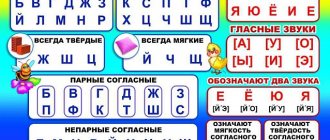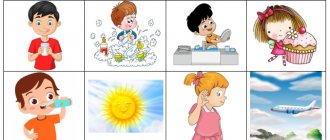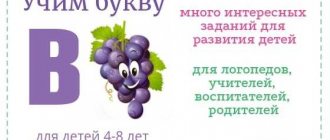Master class on creating solid type from fabric
Step-by-step instructions on how to make three-dimensional letters with your own hands from paper or foam, which are then covered with fabric:
- First of all, take cardboard, a pencil and a ruler. Draw the letter pattern. Remember that you will need a front and back piece, as well as a side piece.
- Using scissors, cut out all the cardboard elements needed to create the letters.
- If you are making letters from foam, cut the material into as many pieces as you need letters. Draw a letter template on each of them. After this, cut out the shapes with a stationery knife with a sharp blade.
- Lay out a piece of fabric with the reverse side in front of you.
- Draw letters on the fabric. Each must be in two copies (front and back). Moreover, they will be larger in size than the finished figures. The sides are taken into account here. For example, if the width of the letter is ten centimeters, and the side is five centimeters, then the size of the template on the fabric should be thirteen to fourteen centimeters.
- Cut out parts for the product from fabric.
- Warm up the glue gun.
- Carefully glue the fabric to the cardboard or foam model. First one side is glued, then the other. The fabric joints are carefully smoothed out.
- Cover all the letters in the same way.
Solid volumetric fabric letters are ready!
Riddles for children starting with the letter J
When it boils, steam comes out, and it whistles and bursts with heat, the lid rattles and knocks. - Hey, take me off! - shouts. (Kettle)
Amazing carriage! Judge for yourself: The rails are in the air, and he holds them with his hands. (Trolleybus)
In a woolen clearing, a thin-legged animal dances. A stitch creeps out from under a steel shoe. (Sewing machine)
It might break. It can be boiled, If you want, it can turn into a bird. (Egg) Tell me, who is so afraid of things, Like a dog is afraid of a stick, Like a bird is afraid of a stone? (Lazy person)
I run to my mother river and cannot remain silent. I am her own son, and was born in the spring. (Creek)
He produces sheets of Wide Latitude. Supported by strong stems One hundred rough, tenacious fruits: If you don’t get around them, you’ll find them all on yourself. (burdock)
He grew up in a field angry and prickly, There were needles in all directions. (burdock)
I am always friendly with the light. If the sun is in the window, I run along the wall from the mirror, from the puddle. (Sunny bunny)
There is a button on the head, a sieve in the nose, one hand, and even that on the back. (Kettle)
Fabric letters
Fabric letters can be either hard or soft.
To create solids you will need to take the following tools and materials:
- cardboard or foam;
- scissors;
- stationery knife;
- pencil;
- ruler;
- scotch;
- special glue gun;
- beautiful fabric.
To create soft letters you will need to take the following tools and materials:
- fabric (for example, cotton, felt, etc.);
- filler (for example, padding polyester, padding polyester, cotton wool, holofiber, air fluff, cereal, and so on);
- tailor's scissors;
- a needle;
- threads;
- sewing machine (if you have one, it will greatly facilitate the work process).
Operating procedure
Step-by-step instructions on how to make three-dimensional letters with your own hands from paper:
- Using a pencil and ruler, draw the front and back of the letter on the cardboard.
- Draw the sides of the letter next to each other. Make the length generous, and the width as desired. If you want the letter to be able to be used independently, then the size should be approximately 1:4 (for example, the height of the letter is 20 centimeters and the width is 5 centimeters).
- Take the tape and glue the side flap to one side of the letter. Then glue the other part.
- Set the tone of the putty. To do this, add color to it. Remember that when the putty on the paper dries, it will become slightly lighter than in the jar.
- Using a spatula, apply putty to the entire letter. Don't forget to caulk the joints.
- Let the putty dry. This will take about twelve hours.
- Gently smooth out any uneven surfaces using fine-grained sandpaper.
Three-dimensional letters made of cardboard, made by hand, are ready.
Tale about the letter Y
What do you know about yoga?
“What do you know about yogis?” - that was the name of the book that Mouse the mouse found in the garden. On the cover there was a picture of a naked guy - a yogi, who, as if nothing had happened, was lying on nails sticking out of the board. In other pictures, the same yogi simply stood with his bare feet on hot coals or sat frozen in a block of ice. In addition, Mouse read that yogis can go for months without eating or drinking. - Need to try! - decided Mouse. “I can imagine what will happen when mom opens the refrigerator, and I’m sitting there frozen and smiling. Or dad opens the stove, and I sit there on the coals and say: “What, I’ve never seen yoga, or what?”
To begin with, he hammered nails into the board and just lay down on them, when he immediately jumped up and started yelling at the whole garden:
- Ohhhhh!!!
He ran home, took out iodine and began to smear the nail scratches on himself. And iodine burns! Mouse smears, groans, and thinks: “I’ll throw this book to the cat.” Let him be a yogi now.”
(G. Yudin)
Assignment: printed letter Y for preschoolers
Examine the letter Y. Sew the letter Y in the air and once in the notebook, carefully in the cells with a simple pencil or ballpoint pen.
In cases where the child is asked to write a whole line of a letter, syllable or word, the adult gives a writing sample at the beginning of the line. If a preschooler has difficulties, then an adult can draw two approximate lines, or put reference points that the child will connect with lines, or write the entire letters, and the child will simply circle them in a different color. Calligraphy should not be required at this stage of training.
Print
What types of three-dimensional letters are there?
Do-it-yourself volumetric letters can be made from the following materials:
- Paper (for example, cardboard). Such letters are most often empty inside and very light. Suitable as room decor (they can be hung on the wall), holiday attribute or photography.
- Fabrics (cotton, satin, felt, etc.). Such letters turn out to be very soft, so they are suitable not only as decoration and for photography, but they can also be used as beautiful and original pillows.
- Foam plastic. Such letters are distinguished by the fact that they can easily be decorated with almost any material (for example, paints, ribbons, paper, flowers, rhinestones, and so on). They are as light as three-dimensional paper letters.
You can make templates with your own hands on plain paper. The purpose of creating them is to imagine what the final result will look like, correctly calculate the dimensions and choose the font.





